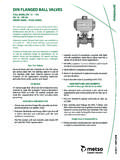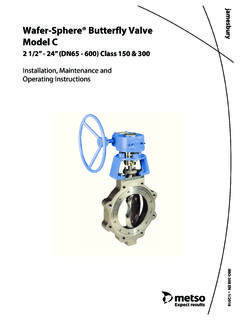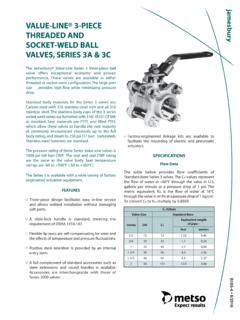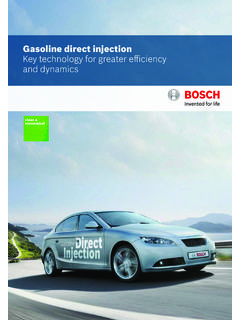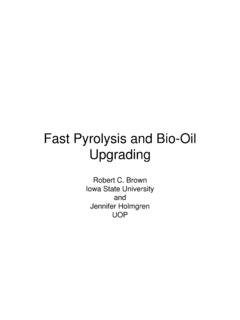Transcription of Propane dehydrogenation – Reactor and product …
1 APPLICATION REPORT2722/45/01 EN 1/2018 Propane dehydrogenation Reactor and product recoveryReactorsRegenerationgasDryerwast eDryer switchingvalvesDryerDryerCLOSEOPENS eparatorCold boxHydrogenFuel gasCLOSEOPENR efluxdrumCLOSEOPENC ompressorFurnace(s)DepressurizingvalveCL OSEOPENP ropyleneproductCLOSEOPENR efluxdrumVentgasPropanerecycleFuel gasCLOSEOPENFuel gascontrolPropanerecycleHydrogenrecycle( optional)CLOSEOPENCLOSEOPENP ropanefeedCLOSEOPENR egeneration air/regenerated catalystExhaust air/deactivated catalystSelectivehydrogenation(optional) CLOSEOPENThis diagram is intendedto be a representation andshould not be viewed as anactual process flow shut-offvalveSeparator(Regen .)(Oper.)EthylenecolumnPropane-propylene splitterProcess overviewPropane dehydrogenation (PDH) is used to produce polymer-grade propylene from Propane independent of a steam cracker or fluid catalytic cracking unit. It provides a dedicated and reliable source of propylene to meet the growing market demand for propylene and gives more control over propylene feedstock Propane feed is mixed with recycled Propane and optionally also with recycled hydrogen gas and is fed into a heater to be heated to over 540 C (1000 F) and then enters the reactors to be converted at high mono-olefin or four reactors are usually used and they are operated either in series or in parallel.
2 When the reactors are operated in series, interstage heaters are used to maintain the reaction through supplying heat, since the reaction is endothermic. Catalyst activity is maintained by continuous catalyst regeneration or by utilizing regeneration air. Reactors operated in series utilize continuous catalyst regeneration, where catalyst is continuously withdrawn from the Reactor , regenerated, and then fed back into the Reactor bed. For reactors operating in parallel, catalyst activity is maintained by shutting down the reactors one by one and regenerating the catalyst by using heated regeneration propylene-rich Reactor effluent is compressed, dried and sent to a cryogenic separator where hydrogen is recovered. The olefin product is then optionally sent to a selective hydrogenation process where dienes and acetylenes are saturated to olefin stream then goes to an ethylene column where light-ends are removed prior to the Propane -propylene splitter where propylene is recovered.
3 Unconverted feedstock is recycled and combined with the fresh EN Propane dehydrogenation Reactor AND product RECOVERY 2 APPLICATION REPORT 1/18 Propane dehydrogenation valvesReliable valve performance is critical in a Propane dehydrogenation process. Potential runaway situations require robust safety valve designs to provide relief systems in case of sudden pressure or temperature increases. Some media present in a Propane dehydrogenation process are also highly are also responsible for ensuring efficient recovery of hydrogen sulphide through molecular sieve beds. Unsatisfactory hydrogen sulphide recovery could poison downstream catalysts or damage equipment. Thus, proper valve performance is important so that process uptime and efficiency can be feed shut-off valvesLocated following the heater, these emergency shut-off valves must promptly isolate the feed to the Reactor in case of an upset scenario. There are separate isolation valves for the feed and regeneration is imperative that these valves function correctly when needed, even after an extended period of non-operation.
4 Quick operation and tight shut-off are essential. The temperature is extremely high, from around 400 C (750 F) up to 540 C (1000 F).Metso solution for Reactor feed shut-offMetso Neles trunnion mounted ball valves with a ValvGuard intelligent safety solenoid to ensure reliable operation in case of an upset. High temperature compatible, with special construction and materials making the valve applicable up to 600 C (1100 F) Long lasting tight shut-off, up to ANSI Class V Increased availability with advanced diagnostics and possibility for partial stroke testing Quick operation without additional instrumentation due to high pneumatics capacity Simple and compact valve instrumentation provided by ValvGuardColumn heat and product controlPropane dehydrogenation processes usually utilize several columns including an ethylene column (or deethanizer) and a Propane -propylene splitter. Column operation is a balance between energy consumption and separation efficiency. A lower reflux rate requires less heat in the reboiler, conserving energy but decreasing separation ensure that the valve does not adversely affect separation efficiency, accurate and stable control is required of the valve.
5 Flow media are also toxic and flammable, making emissions a concern. A common problem with column operations is also poor loop sensitivity caused by improperly sized (oversized) valvesMetso solution for column controlNeles linear globe valves provide the foundation for stable and reliable column operations. Wide range of trim designs and a wide valve size range ensures compatibility with various column applications Fugitive emission certified according to ISO15848-1 Minimize process deviations with accurate control profile calibration enabled by intelligent ND valve controller Reliable valve sizing with Metso valve sizing software since valve installed characteristics are also analysed Neles globe valve Propane dehydrogenation Reactor AND product RECOVERY 2722/45/01 EN APPLICATION REPORT 1/18 3 FuelShut-offvalvesControlvalveESD/ESVval vesTo burnersVent gasTo othershut-off valvesValve testarrangementVent gasSimplified schematic of a typical burner valve setupFuel gas/oil control valveHeaters create heat required to maintain the reaction and convert the feedstock since the dehydration reaction is different heat generation properties of the fuels require a valve which can regulate the flow accordingly.
6 Typically, the temperature is 40 200 C (100 400 F) and the pressure 2 10 barG (30 150 psig).Metso solution for fuel gas/oil controlMetso offers two types of valves which are well-suited for fuel gas/oil control. The selection of valve type depends on the type of fuel and rangeability Neles balanced cage guided globe valve with a VD spring diaphragm actuator and an ND valve controller is well suited for the application if there is limited variety in the type of fuel used and good rangeability is required Different inherently characterized trims, available as equal percentage, linear and quick open Interchangeable trim parts making it possible to easily change flow characteristics Accurate and sensitive actuator ensuring fast and proper operation of the valve Easy maintenance Top entry construction for easy access, valve assembly is simple and self-guiding Low-friction actuator operation improving efficiency and control performanceIf the type of fuel being used varies and/or extremely high rangeability is required, the Neles rotary V-port segment valve and an ND valve controller is the optimal solution.
7 Best possible rangeability, ensuring that the same valve can be used for various types of fuel No potential leak paths even if subjected to pipe bending forces, as the valve features a one-piece body construction Reduced fugitive emissions by design, as the valve utilizes rotary operation which is inherently less prone to leaks Economical Low torque requirements reduce wear and reduces actuator size, increasing reliability and reducing costs Fire-safe compliant according to API 607 Q-Trim design available, eliminating noise and the potential for cavitation to occur Neles segment valve2722/45/01 EN Propane dehydrogenation Reactor AND product RECOVERY 4 APPLICATION REPORT 1/18 Burner shut-off and ESD valvesGas flows into the burners through a series of two ESD valves that have a vent (ESV) between them. The vent is used to prevent pressure build up and flow through the second isolation valve when the system is isolated. The ESD valves automatically shut off the supply of fuel when de-energized by a combustion safety control, safety limit control, or loss of actuating medium.
8 The gas then flows to burner shut-off valves before entering the functioning in case of an upset is imperative. Type approvals are also becoming a standard requirement by local authorities in different countries. Typical process conditions are similar to the control solution for burner shut-off/ESDM etso Jamesbury soft-seated ball valves with a B1-series piston actuator and a ValvGuard safety solenoid to ensure operability in case of an upset for ESD/ESV shut-off valves, Jamesbury ball valves with a Valv-Powr VPVL actuator provide excellent tightness during shut-off Field proven Xtreme seat & Lip-Seal capabilities in both continuous and on-off (switching) heating Safe and reliable bubble tight shut-off even after a million cycles and the self-relieving feature (cavity relief ) provides safe operation after a long time of non-movement Partial stroke testing capability with the ValvGuard safety solenoid Fire-safe design acc. to API 607 or ISO 10497 Low fugitive emission approvals by third party authorities Compliance up to SIL 3 by third party certifications Gas burner valve type approvals acc.
9 To EN161, EN264,ISO 23553-1, AGA, FM and CSAJ amesbury ball valveReactor depressurizing valvesThe selective hydrogenation Reactor depressurizing valve is designed to open in case of over-pressurization to ensure safe operation during upset conditions. Most depressurizing systems utilize two depressurizing valves: a slow operational depressurizing valve and a fast emergency depressurizing valve. Local safety regulations may necessitate the presence of redundant valves to ensure that depressurization can occur in case one valve reliability and fast operation is required of the Reactor depressurizing valves, since the valves must open immediately in case over-pressurization or other upsets occur. Tight shut-off and robust stem packing are necessary to prevent leaks, which cause loss of product and potential safety issues if volatile hydrocarbons enter the facility. Noise reduction capabilities and fire safe designs are typically also solution for Reactor depressurizingMetso Neles metal seated ball valve, with a special noise reducing Q-Trim, equipped with pneumatic B1-series actuator and Neles ValvGuard intelligent safety solenoid.
10 Avoid unnecessary flaring due to long lasting metal seated tightness and partial stroke testing with ValvGuard Emission proofing with rotary technology and standard live-loaded packing Advanced online diagnostics enabling predictive maintenance Fire proofing available and fire safe certified design as standard Prevent too fast depressurizing by utilizing special trims with capacity limitationsNeles ball valve Propane dehydrogenation Reactor AND product RECOVERY 2722/45/01 EN APPLICATION REPORT 1/18 5 Dryer switching valvesThe dryers are used to remove trace amounts of water formed from catalyst regeneration and to remove hydrogen sulfide. The valves play an important role in directing the inlet/outlet stream of gas between the dryer columns, switching the columns from adsorption phase into regeneration phase in a pre-set sequence. Natural gas or hydrogen at a high temperature of around 250 C (480 F) is used to regenerate the adsorption valves should withstand fluctuations in temperature while keeping bi-directional tightness over a period of several years of operation.



